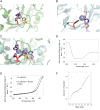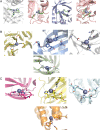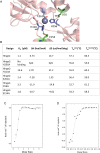Probing the minimal determinants of zinc binding with computational protein design
- PMID: 27358168
- PMCID: PMC4955873
- DOI: 10.1093/protein/gzw026
Probing the minimal determinants of zinc binding with computational protein design
Abstract
Structure-based protein design tests our understanding of the minimal determinants of protein structure and function. Previous studies have demonstrated that placing zinc binding amino acids (His, Glu, Asp or Cys) near each other in a folded protein in an arrangement predicted to be tetrahedral is often sufficient to achieve binding to zinc. However, few designs have been characterized with high-resolution structures. Here, we use X-ray crystallography, binding studies and mutation analysis to evaluate three alternative strategies for designing zinc binding sites with the molecular modeling program Rosetta. While several of the designs were observed to bind zinc, crystal structures of two designs reveal binding configurations that differ from the design model. In both cases, the modeling did not accurately capture the presence or absence of second-shell hydrogen bonds critical in determining binding-site structure. Efforts to more explicitly design second-shell hydrogen bonds were largely unsuccessful as evidenced by mutation analysis and low expression of proteins engineered with extensive primary and secondary networks. Our results suggest that improved methods for designing interaction networks will be needed for creating metal binding sites with high accuracy.
Keywords: Rosetta; metalloproteins; protein design; zinc binding.
© The Author 2016. Published by Oxford University Press. All rights reserved. For Permissions, please e-mail: journals.permissions@oup.com.
Figures





Similar articles
-
De novo design of buttressed loops for sculpting protein functions.Nat Chem Biol. 2024 Aug;20(8):974-980. doi: 10.1038/s41589-024-01632-2. Epub 2024 May 30. Nat Chem Biol. 2024. PMID: 38816644 Free PMC article.
-
Engineering the zinc binding site of human carbonic anhydrase II: structure of the His-94-->Cys apoenzyme in a new crystalline form.Biochemistry. 1993 Feb 16;32(6):1510-8. doi: 10.1021/bi00057a015. Biochemistry. 1993. PMID: 8431430
-
A novel serine protease inhibition motif involving a multi-centered short hydrogen bonding network at the active site.J Mol Biol. 2001 Apr 13;307(5):1451-86. doi: 10.1006/jmbi.2001.4516. J Mol Biol. 2001. PMID: 11292354
-
Designing hydrolytic zinc metalloenzymes.Biochemistry. 2014 Feb 18;53(6):957-78. doi: 10.1021/bi4016617. Epub 2014 Feb 7. Biochemistry. 2014. PMID: 24506795 Free PMC article. Review.
-
Structural biology of zinc.Adv Protein Chem. 1991;42:281-355. doi: 10.1016/s0065-3233(08)60538-0. Adv Protein Chem. 1991. PMID: 1793007 Review.
Cited by
-
Engineering glycoside hydrolase stability by the introduction of zinc binding.Acta Crystallogr D Struct Biol. 2018 Jul 1;74(Pt 7):702-710. doi: 10.1107/S2059798318006678. Epub 2018 Jun 27. Acta Crystallogr D Struct Biol. 2018. PMID: 29968680 Free PMC article.
-
SuperMetal: A Generative AI Framework for Rapid and Precise Metal Ion Location Prediction in Proteins.bioRxiv [Preprint]. 2025 Mar 25:2025.03.21.644685. doi: 10.1101/2025.03.21.644685. bioRxiv. 2025. Update in: J Cheminform. 2025 Jul 15;17(1):107. doi: 10.1186/s13321-025-01038-9. PMID: 40196543 Free PMC article. Updated. Preprint.
-
Rapid Sampling of Hydrogen Bond Networks for Computational Protein Design.J Chem Theory Comput. 2018 May 8;14(5):2751-2760. doi: 10.1021/acs.jctc.8b00033. Epub 2018 Apr 20. J Chem Theory Comput. 2018. PMID: 29652499 Free PMC article.
-
SuperMetal: a generative AI framework for rapid and precise metal ion location prediction in proteins.J Cheminform. 2025 Jul 15;17(1):107. doi: 10.1186/s13321-025-01038-9. J Cheminform. 2025. PMID: 40665445 Free PMC article.
-
Binding Site Configurations Probe the Structure and Dynamics of the Zinc Finger of NEMO (NF-κB Essential Modulator).Biochemistry. 2017 Jan 31;56(4):623-633. doi: 10.1021/acs.biochem.6b00755. Epub 2017 Jan 13. Biochemistry. 2017. PMID: 28035815 Free PMC article.
References
-
- Andreini C., Bertini I. (2012) J. Inorg. Biochem., 111, 150–156. - PubMed
-
- Andreini C., Bertini I., Cavallaro G., Holliday G.L., Thornton J.M. (2008) J. Biol. Inorg. Chem., 13, 1205–1218. - PubMed
-
- Auld D.S. (2001) Biometals, 14, 271–313. - PubMed
-
- Azia A., Levy R., Unger R., Edelman M., Sobolev V. (2015) Proteins Struct. Funct. Bioinforma., 83, 931–939. - PubMed
-
- Browner M.F., Hackos D., Fletterick R. (1994) Nat. Struct. Mol. Biol., 1, 327–333. - PubMed
Publication types
MeSH terms
Substances
Grants and funding
LinkOut - more resources
Full Text Sources
Other Literature Sources

